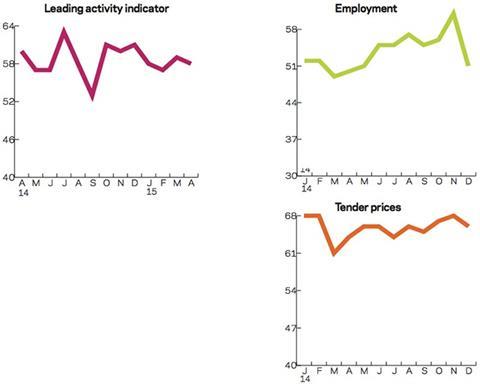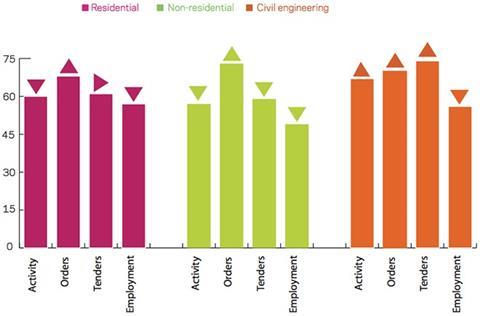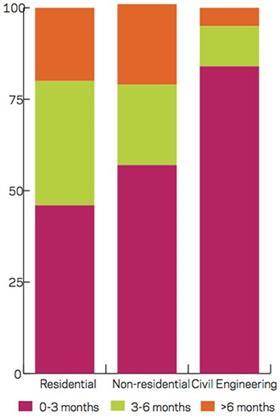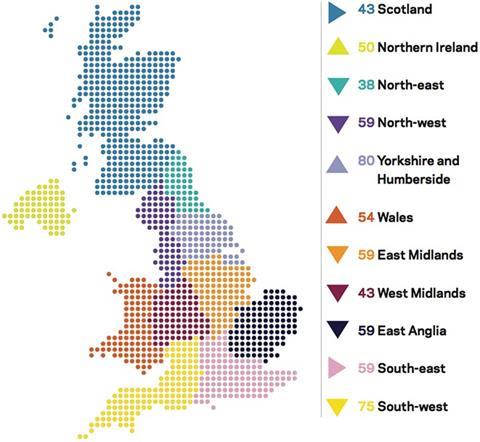The construction activity index sees a one-point increase for the month to take it to 61 points, while the majority of regional indices saw a decrease in activity
01 / State of play
The construction activity index stood at 61 points in December, representing a one-point increase on a monthly basis. At the sector level, residential and non-residential activity fell on a monthly basis to 60 and 57 respectively, whereas civil engineering increased by five points to 67. Repair and maintenance (R&M) activity climbed 14 points to 52, bouncing back into expansion territory after three months of poor performance.
The orders index climbed by one point to 69, it has now remained over 60 for 11 consecutive months. Tender enquiries also expanded.
In December, the percentage of respondents reporting no constraints to activity dropped by 14 percentage points to 20%. This indicated an overall increase in factors which could adversely affect activity among the panel of construction firms. Of these factors, insufficient demand has become slightly more significant, rising by four percentage points to reach 36%. Bad weather has become more of an issue as it accounted for 9% of all constraints in December, up from 5% a month earlier. Those indicating that labour shortages were restricting productivity rose to 13% in December. On a monthly basis there was little variation in the significance of material/equipment shortages and financial constraints.
The employment prospects index stood at 51 points in December after falling 10 points on the previous month’s level. The index has now remained above 50 for nine consecutive months. Despite its sustained positive performance, December’s fall suggests that employers are less likely to increase staffing in the coming three months than they were in the latter half of 2014.
Tender prices fell two points in December to reach 66. Despite this fall, the series has now remained above 60 for 12 consecutive months. This suggests we are in the midst of a sustained and robust expansion in tender prices.
02 / Leading construction activity indicator

CFR’s Leading Construction Activity Indicator1 for December gained one point on a monthly basis to reach 61. It has remained at or above 50 in each month since September 2012.
The indicator uses a base level of 50: an index above that level indicates an increase in activity, below that level a decrease.


03 / Work in hand
During December 2014, a large proportion of civil engineering respondents reported less than three months of work in hand (84%), while for the residential and non-residential sectors this was 46% and 57% respectively. At 34% the residential sector has the highest amount of work in hand over the next three-to-six months. The non-residential sector reported that 22% of work was available after six months. Approximately 20% of residential firms reported that they had more than six months of work in hand. Civil engineering firms reported the lowest amount over the same period, with just 5% being available after six months.
04 / Regional perspectives
Experian’s regional composite indices incorporate current activity levels, the state-of-order books and the number of tender enquiries received by contractors to provide a measure of the relative strength of each regional industry.
The majority of regions and devolved nations saw a decrease in activity in December. The largest fall was seen by East Midlands’ index (59), with a nine-point contraction. Three of the 12 regions remained in negative territory: Scotland had no index movement, remaining at 43, while the West Midlands and the North-east delved further into negative territory, falling to 43 and 38 points respectively. Northern Ireland saw an increase of five points to reach the no-change mark of 50. Yorkshire & Humberside’s index stayed strong, gaining 11 points to reach 80. Wales was the only other region to see an expansion, rising by two points to 54. Activity in the South-east did not differ on a monthly basis, remaining at 59, extending its run around the 60-mark. The North-west and East Anglia stood at 59 with downticks of four points and one point respectively.
The UK index, which includes firms working in five or more regions, saw a reduction of three points to 61.

Notes
This an extract from the monthly Focus survey of construction activity undertaken by Experian Economics on behalf of the European commission as part of its suite of harmonised EU business surveys. The full survey results and further information on Experian Economics’ forecasts and services can be obtained by calling 0207-746 8217 or logging on to .
The survey is conducted monthly among 800 firms throughout the UK and the analysis is broken down by size of firm, sector of the industry and region. The results are weighted to reflect the size of respondents. As well as the results published in this extract, all of the monthly topics are available by sector, region and size of firm. In addition, quarterly questions seek information on materials costs, labour costs and work-in-hand.
1CFR’s Leading Construction Activity Indicator incorporates a range of factors to assess the construction industry’s prospects over the next quarter. The indicator is put together using information about past levels of activity, orders and tender enquiries.







No comments yet